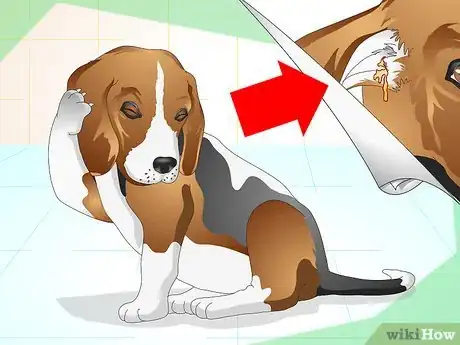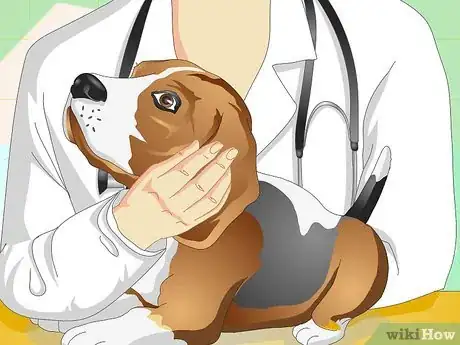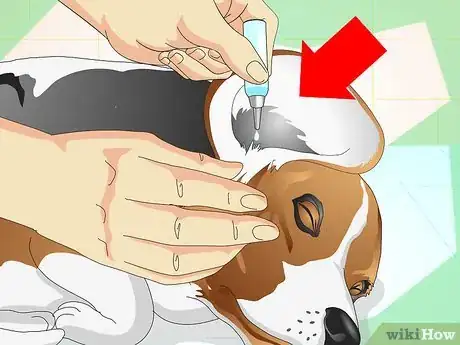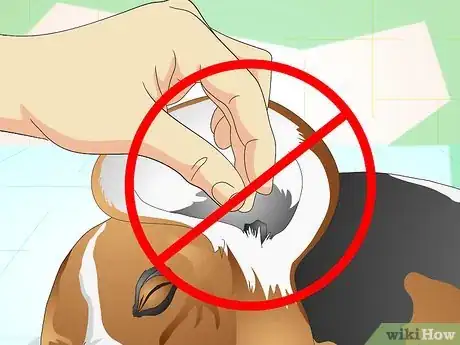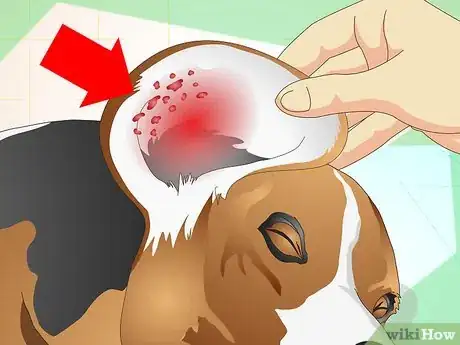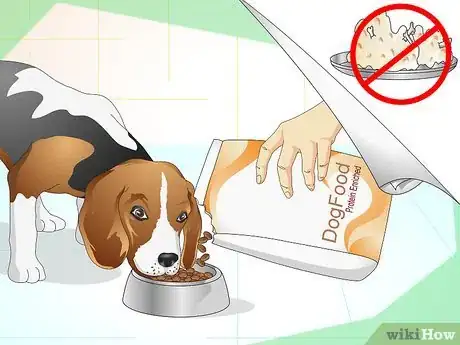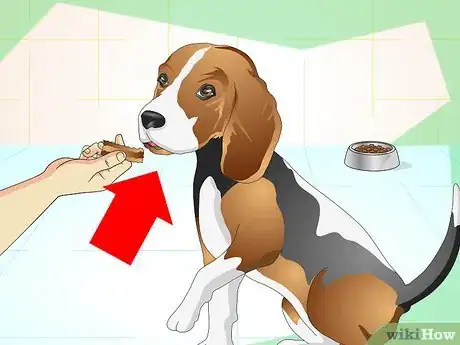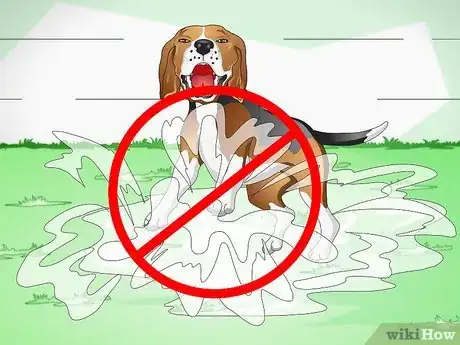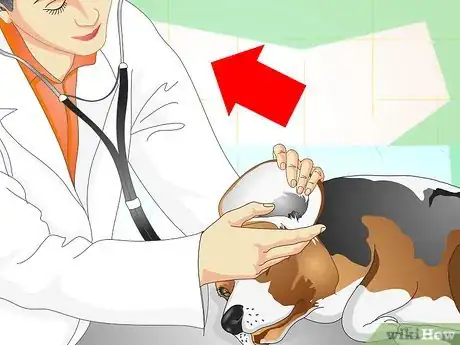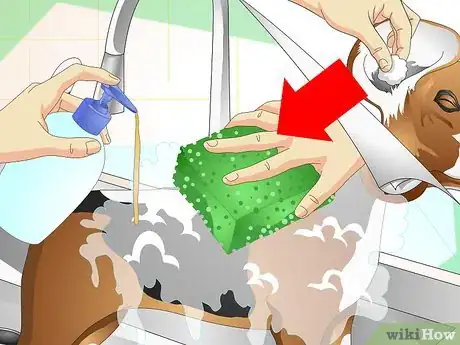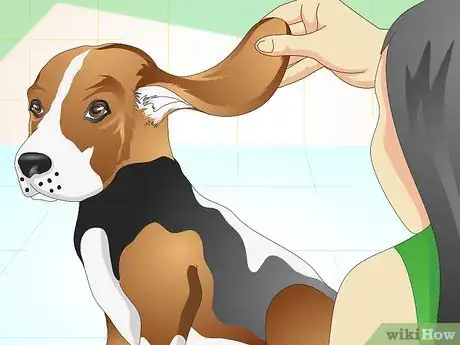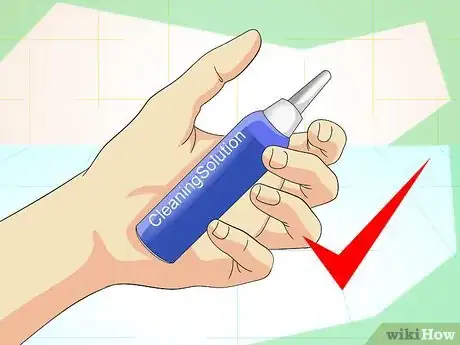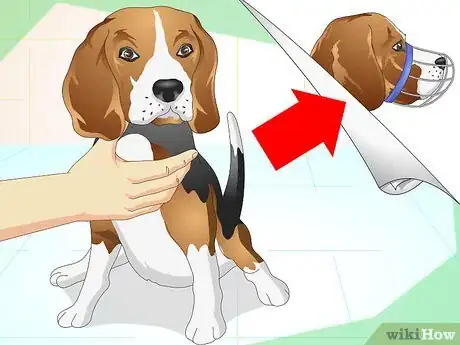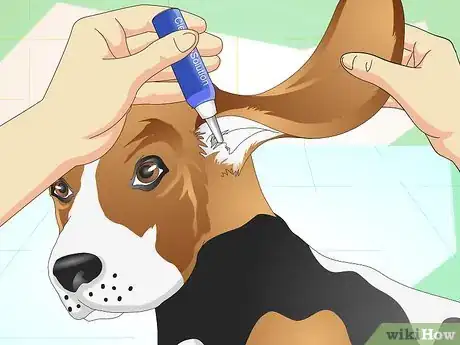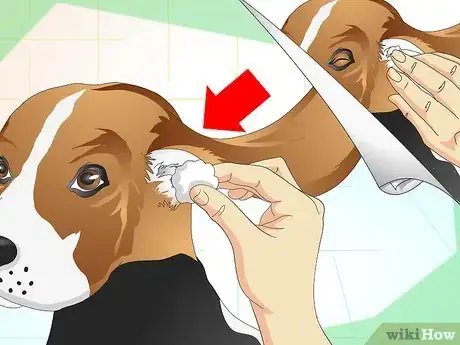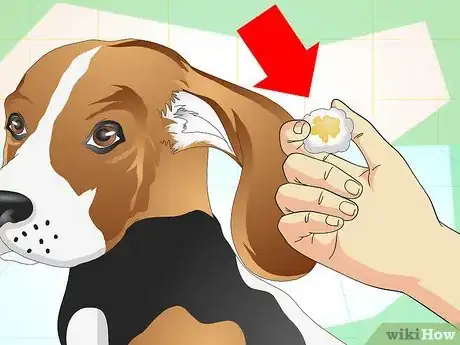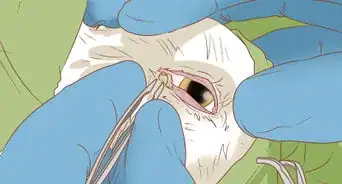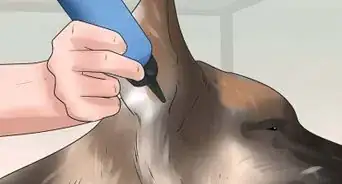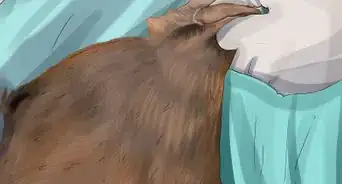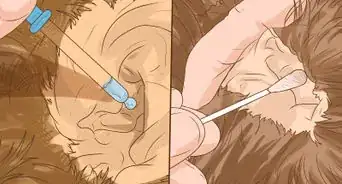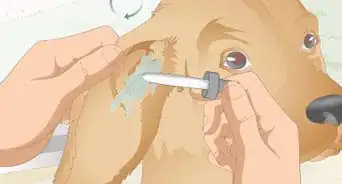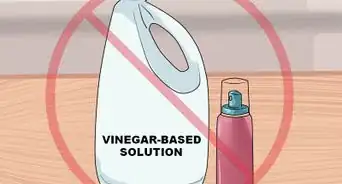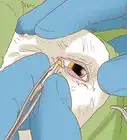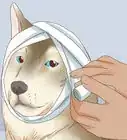This article was co-authored by Pippa Elliott, MRCVS. Dr. Elliott, BVMS, MRCVS is a veterinarian with over 30 years of experience in veterinary surgery and companion animal practice. She graduated from the University of Glasgow in 1987 with a degree in veterinary medicine and surgery. She has worked at the same animal clinic in her hometown for over 20 years.
There are 9 references cited in this article, which can be found at the bottom of the page.
wikiHow marks an article as reader-approved once it receives enough positive feedback. In this case, 98% of readers who voted found the article helpful, earning it our reader-approved status.
This article has been viewed 533,800 times.
If you notice your dog scratching his/her ear, shaking their head, or smelly colored discharge coming from their ears, your dog may have an ear infection. Ear infections are common problems in dogs and can occur in the outer, middle or inner ear. Ear infections usually begin with inflammation of the outer ear canal, caused by bacteria or yeast. But, ear infections in dogs can be caused by food allergies, parasites, foreign bodies, trauma, excess moisture in the ear or hereditary conditions. If you think your dog has an ear infection, take them to the vet for treatment. Then learn how to prevent ear infections and properly clean your dog's ears.
Steps
Treating Your Dog's Ear Infection
-
1Look for symptoms of an ear infection. Pay attention to any unusual behavior changes in your dog and for physical symptoms like:[1]
- Ear scratching
- Brown, yellow or bloody discharge
- Odor in the ear
- Redness
- Swelling
- Crusted or scabby skin on the near ear flap
- Hair loss around the ear
- Wiping the ear area on the floor or furniture
- Head shaking or head tilt
- Loss of balance
- Unusual eye movements
- Walking in circles
- Hearing loss
-
2Know when to take your dog to the veterinarian. If your dog has any symptoms of ear infection, you should take him to the vet as soon as you can. Ear infections are very painful. Some dogs will let you know they're hurting and may become more aggressive, while others don't show the pain.[2]
- Either way, it's important to get treatment immediately, since untreated ear infections can damage the ears.[3]
Advertisement -
3Treat the infection. Ear infections are often caused by yeast/fungus, bacteria, or both at the same time. Your veterinarian will probably have you apply a topical antibiotic or give an oral antibiotic to treat a bacterial infection. For a fungal infection, you will likely be instructed to use an anti-fungal ear wash, topical medication, and maybe give an oral anti-fungal medication.[4]
-
4Avoid trying to remove anything stuck in your pet's ear. If you know or suspect that a foreign object is stuck in your pet's ear, this may be introducing and causing the ear infection. The ear infection will not go away until the object is removed. Never try to remove the object yourself.[5] Instead, take your dog to the vet.
- Because the ear canal is L shaped, foreign objects may be deep in the ear, out of plain sight. Specialized instruments and physical or chemical restraint are usually needed to safely remove a foreign body. This is why it's important to let your vet handle it.
Treating Underlying Causes and Preventing Ear Infections
-
1Determine if your dog has allergies. Allergies are often the primary source of inflammation in the ear, which makes the ears more susceptible to infections.[6] While it may be difficult to determine an allergic cause, it helps to start paying attention to factors such as if new foods or treats were introduced before the ear infection flared up. If they contained a particular protein, you may want to avoid that giving your dog that protein.
- Animal proteins and dairy products in food are more likely to cause allergies for pets than grains are, despite the popularity of the notion that grain free diets are better for dogs with food allergies.[7]
-
2Try putting your dog on a diet trial. Specifically, put your dog on a diet trial with a novel, or new, protein, one your dog has never eaten before. New prescription diets should be fed exclusively for at least 8 weeks and ideally for a minimum of 12 weeks.[8] Give no treats, table scraps or other food sources during this time.
- This may help to determine if food proteins are the problem and home in on which are culprits. The best novel protein diets are prescription formulas because they will have the least likely chance of cross-contamination with other protein sources, but they are often the most expensive choice.
-
3Challenge your dog's diet. At the end of the trial, if your dog is not showing signs of ear inflammation or skin allergies (most commonly itchy paws and sometimes itching of other areas of the body), then you can 'challenge' your dog's diet with a single type of treat or the old food. If you notice signs of irritation near the ears, feet, or skin when you re-introduce the old food or treat, then you know that this food or any food containing this protein should be eliminated.
- If the ear infections tend to spring up at the same time of year every year, a seasonal environmental allergy may be causing the ear infections.
-
4Restrict your dog's activity. While your dog has an ear infection, you should make sure he doesn't get excess moisture in his ears. Avoid letting your dog play in water, swim, bathe, or be groomed until the ear infection has cleared up. Extra moisture will aggravate the ear infection and make it last longer.[9]
-
5Follow up with your veterinarian. Keep checking in with the veterinarian until the ear infection is completely gone. Some ear infections are mild and easily treated in 1-2 weeks with topical medications and cleaning. Some infections are more complicated and may take many weeks, further testing, treatments or procedures to treat.
- Follow your veterinarian's recommendations about when to check in, since the vet can help you determine if the ear infection is cleared or if more needs to be done.
-
6Prevent ear infections. Once your dog has had an ear infection, he's more likely to struggle with them throughout his life. The good news is that there are several things you can do to prevent ear infections in your dog. Here are several preventative measures:[10]
- avoid letting your dog swim or bathe too frequently
- plug your dog's ears with cotton before bathing him
- flush your dog's ears with a product containing salicylic acid (which helps wet ear canals dry)
- check and treat any allergies your dog may have
- frequently clean your dog's ears
Cleaning Your Dog's Ears
-
1Know when to clean your dog's ears. Follow your veterinarian's instructions about how many times per day or week to clean your dog's ears. If your dog has an ear infection, have your vet check his ears to make sure the eardrum has not been damaged or ruptured. Cleaning ears that have a damaged eardrum can make them worse, not better. Cleaning the ears too often cause also harm the ears.[11]
- Signs of a ruptured eardrum include pain, head tilting toward the affected side and sometimes even rapid jerky eye movements and/or dizziness.
-
2Get a cleaning solution. It is best to use a veterinarian recommended dog ear cleaning solution, but many over-the-counter ear flush options are available at your local pet store. These are often effective for routine ear cleaning but don't use them to clean infected ears if they contain alcohol or other harsh ingredients. These can be painful and irritating.
- If your dog has an infection, your veterinarian may prescribe an ear flush specifically formulated to break up wax, break down bacterial cell walls, and treat yeast causing the infection.
-
3Position your dog. Have your dog sit with his back up against a wall or in a corner of a room. This will help you keep him still and prevent him from running away during the ear cleaning. Because ears can be very painful, and because you’re working with your pet's face, use a muzzle if you need to or if your pet may be likely to try to bite. It may also help to have a gentle grip over and around the muzzle to hold your pet's head still.
- Remember that even the sweetest animals can and may bite when they are in pain. It may help to have an extra person around to help hold your dog in place and keep his head still.
-
4Apply the cleaning solution. Pour some of the cleaner into your dog's ear canal according to the directions on the bottle. Massage his ear at the base for 20 to 30 seconds to help the cleaner move around and agitate any debris.
-
5Plug and massage the ear. Use a cotton ball to plug the ear, then repeat the massaging technique underneath the opening of the ear. This will push the cleaning fluid into the cotton ball to be soaked up. Debris should also stick to the underside of the cotton ball. Be sure to only push the cotton into the vertical canal, until it plugs the opening, but can be easily retrieved.[12]
- The anatomy of your dog's ear is different from your ear. Dogs have an L-shaped ear canal, containing a vertical canal you can see into, with a nearly 90 degree turn into the horizontal portion of the canal (this is an area you cannot see).
-
6Remove and examine the cotton ball. Remove the fluid soaked cotton ball and look at the bottom surface for wax or discharge. Use a cotton ball to wipe the dirt out of the visible, exterior parts of the ear. Gently wipe the inner ear flap and around the ear with a dry, soft towel to clean loose dirt and moisture.[13]
- If there is a lot of debris on the cotton ball, then repeat the rinse, agitate, and absorb procedure again.
Expert Q&A
Did you know you can get expert answers for this article?
Unlock expert answers by supporting wikiHow
-
QuestionWhy does my dog walk sideways with his head tilted and keep falling down?
 Pippa Elliott, MRCVSDr. Elliott, BVMS, MRCVS is a veterinarian with over 30 years of experience in veterinary surgery and companion animal practice. She graduated from the University of Glasgow in 1987 with a degree in veterinary medicine and surgery. She has worked at the same animal clinic in her hometown for over 20 years.
Pippa Elliott, MRCVSDr. Elliott, BVMS, MRCVS is a veterinarian with over 30 years of experience in veterinary surgery and companion animal practice. She graduated from the University of Glasgow in 1987 with a degree in veterinary medicine and surgery. She has worked at the same animal clinic in her hometown for over 20 years.
Veterinarian
Warnings
- Dogs with pendulous ears or hairy inner ear flaps are more prone to ear infections.⧼thumbs_response⧽
- See the veterinarian before treating the ear infection yourself.⧼thumbs_response⧽
References
- ↑ https://www.aspca.org/pet-care/dog-care/ear-infections
- ↑ https://www.aspca.org/pet-care/dog-care/ear-infections
- ↑ http://pets.webmd.com/dogs/dog-ear-infections?page=2
- ↑ William H Miller, Craig E Griffin, Karen L Campbell. Muller and Kirk's Small Animal Dermatology 7th ed. 2013
- ↑ http://pets.webmd.com/dogs/guide/ear-care-dogs
- ↑ William H Miller, Craig E Griffin, Karen L Campbell. Muller and Kirk's Small Animal Dermatology 7th ed. 2013
- ↑ Day MJ, The Canine Model of Dietary Hypersensitivity. Proc Nutr Soc. 2005 Nov;64(4):458-64
- ↑ Rosser EJ Jr, Diagnosis of food allergy in dogs. J Am Vet Med Assoc. 1993 Jul 15;203(2):259-62)
- ↑ Greene, CE. Malassezia dermatitis. In Greene, CE (ed.) Infectious Diseases of the Dog and Cat. W.B. Saunders Co. Philadelphia, PA; 1998: 547-548.
- ↑ https://www.aspca.org/pet-care/dog-care/ear-infections
- ↑ Nuttal T., Cole LK. Ear cleaning: the UK and US perspective. Vet Dermatol. 2004 Apr;15(2):127-36.
- ↑ https://www.cesarsway.com/how-to-clean-dogs-ears/
- ↑ https://www.cesarsway.com/how-to-clean-dogs-ears/
About This Article
The best way to heal ear infections in dogs is to take the dog to the vet to get an antibiotic or antifungal medication. If you see an object in the dogs ear, have a vet restrain or sedate your dog and remove the object for you. Then, while the infection is healing, don’t bathe your dog or let it play in water because the excess water could prolong the infection. You should go back to the vet multiple times during this process in case there are complications. Keep reading for advice from our Veterinary reviewer on preventing ear infections in dogs.
